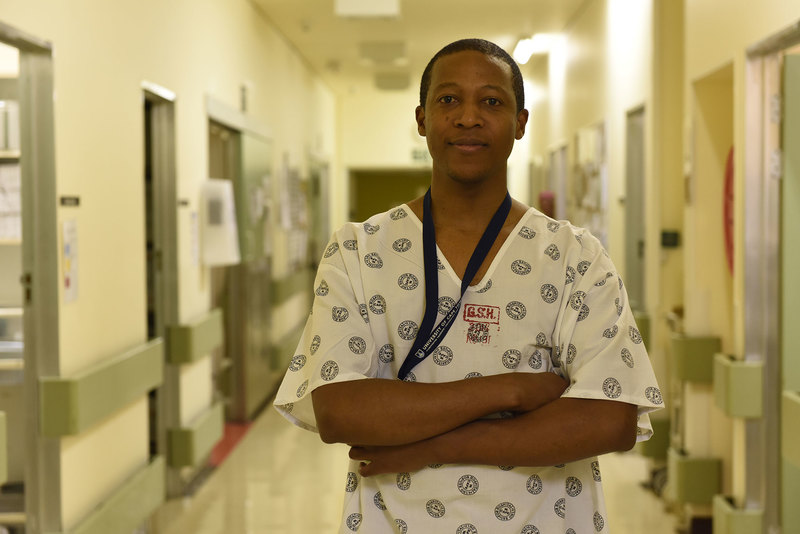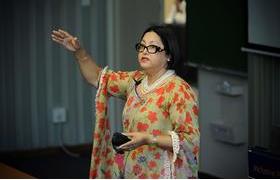Racism in medicine is ‘a horrible injustice’
13 July 2021 | Story Niémah Davids. Photo Michael Hammond. Read time 9 min.
Racism in medicine – underpinned by national and international research, as well as personal experience – were placed under the microscope during a recent academic seminar hosted by the University of the Witwatersrand’s School of Public Health.
The keynote speaker was Professor Ntobeko Ntusi, the chair and head of the Department of Medicine at the University of Cape Town (UCT) and Groote Schuur Hospital (GSH). He provided examples of how the scourge of structural racism affects the medical fraternity, patients, and academic hospitals.
“Martin Luther King Jr stated that ‘of all the forms of inequality, injustice in health is the most shocking and the most inhumane’. That observation rings [as] true today as it did 60 years ago,” said Professor Ntusi.
Profound impact
Structural racism, Ntusi argued, goes beyond individual prejudice. He described it as a perpetual inequity, deeply ingrained in social policy, legislation, law enforcement, the economic system, and the healthcare system.
“It results from the pervasive, misaligned thought process that places one racial [and] ethnic group above another.”
“It results from the pervasive, misaligned thought process that places one racial [and] ethnic group above another. [Racism] is often driven by white supremacist beliefs, and the failure to understand that all humans share homology [in] 99.9% of their DNA,” he said.
Within the healthcare sector, structural racism has “profoundly impacted” the mental and physical health of historically marginalised groups, he said. Research indicates that in all corners of the world, black people have lower life expectancies when compared with white people; and predominantly black communities are more likely to experience a shortage of primary healthcare physicians. In addition, black patients globally experience some of the worst health outcomes when compared with any other racial group.
“On a deeper level, the medical community has also promoted structural racism through biased research and papers published in scientific journals,” Ntusi said.
“Racial discrimination in the healthcare system [in] many countries – including ours – has negative consequences for both patients and healthcare workers; and it leads to a higher illness risk, and in some cases a lower standard of care for black patients.”
The COVID‑19 pandemic has highlighted this. A study published in The Lancet indicated that black Americans are four times more likely to succumb to COVID‑19 when compared with white Americans, and data from other countries revealed a similar pattern. Similarly in South Africa, a healthcare workers’ study (led by Ntusi) at GSH showed that black healthcare workers are also more at risk of contracting COVID‑19. A sister study which surveyed healthcare workers in London corroborated these findings. The results of both studies have not yet been published.
Racism in healthcare
Racism in healthcare manifests in many ways but the common themes, Ntusi said, include neglecting, disbelieving and actively discriminating against patients. A 2016 study found that 73% of white medical students surveyed hold at least one “false belief” regarding biological differences between races. The following beliefs from white medical students were recorded in this study: black people have thicker skin, less sensitive nerve endings, stronger immune systems, and higher pain tolerance levels.
“Researchers noted that these beliefs are centuries old, and some 19th-century doctors used them to justify the inhumane treatment of slaves,” said Ntusi.
These age‑old beliefs, he added, continue to have an impact on modern‑day medicine. In another study, it emerged that black children with appendicitis are less likely than white children to receive appropriate pain medication. A report published in Frontiers in Paediatrics, a leading medical journal, also revealed that doctors are less likely to admit black children to hospital after a visit to the emergency department, and less likely to request blood tests, computed tomography scans or X‑rays for young black children compared with white children.
But patients are not the only ones subjected to racism and discrimination. Black medical students and faculty members are also directly affected.
“These academic centres of excellence fail to uphold their commitment to maintaining diverse, equitable and inclusive environments for black students and faculty.”
“Academic medical centres are where medical students learn to become physicians and [where] faculty members engage in cutting‑edge research education and clinical care. But these academic centres of excellence fail to uphold their commitment to maintaining diverse, equitable and inclusive environments for black students and faculty,” he said.
Ntusi said black faculty members have cited lack of mentorship, lack of sponsorship, promotion and career advancement opportunities, and an overall lack of support as some of challenges they face daily. This, Ntusi said, is the reason for the high attrition rate among doctors from academic medical centres.
“Black students have come to me so many times after I’ve delivered a lecture to thank me for an excellent lecture delivered by a black teacher. I have never taken this as a compliment, but as an indictment of our current reality,” he said.
“In modern‑day South Africa, an abundance of excellent black academics and role models should be the norm for black undergraduate and postgraduate students.”
In disbelief
In recent years, Ntusi has travelled the length and breadth of the country to recruit young black UCT medical graduates to return to the university to specialise in a medical discipline. But their feedback has seldom been favourable.
“I am in constant disbelief – and embarrassed – at the amount of psychological trauma that black medical students and black registrars suffer in institutions like ours. This phenomenon is not unique to UCT, and is reported globally,” he said.
In several studies, black medical students reported social isolation, and experiences of racism and tokenism perpetuated by fellow students and faculty members. Racial bias, Ntusi added, even manifests in the way medical school faculty members describe black students in evaluations.
He told the audience that racism in medicine goes back a long way. As one example, he cited the racially discriminatory practices of the American Medical Association (before the 1960s), which deliberately excluded black members. These practices created biases in relation to speciality training and development of black physicians.
Closer to home, in apartheid South Africa, medical research was carried out on the physical differences between black and white patients, and new theories were subsequently developed to explain perceived differences and to justify the superiority of the white ethnic minority.
“In the hospital where I work [GSH], it was not until about 40 years ago that black registrars were allowed to look after white patients.”
“In the hospital where I work [GSH], it was not until about 40 years ago that black registrars were allowed to look after white patients; and even more recently when black and white patients could be treated in the same ward,” Ntusi said.
“Racism in medicine is not only a horrible injustice, but – as Nelson Mandela put it – ‘a blight on the human conscience’.”
Five‑point treatment plan
To promote racial justice and advance health equity throughout the sector and its domains of influence, Ntusi suggested the following strategies:
- Embed racial and social justice into every aspect of the sector, its culture, systems, policies and practices.
- Build alliances and share power with historically marginalised and minoritised physicians and other stakeholders.
- Ensure that equitable structures for opportunities in innovation and advancement are in place.
- Push upstream to address all determinants of health, and the root causes of inequities.
- Create further pathways for truth, racial healing, reconciliation and transformation of past injustices.
“We need to model tolerance, and practise respect, open‑mindedness and peace in our engagements.”
“We all need to recognise, name and understand our attitudes and actions, including [our] unconscious bias. We must be open to identifying and controlling our implicit biases. We need to model tolerance, and practise respect, open‑mindedness and peace in our engagements. These things need to be part of medical education, as well as part of institutional policies,” he said.
“We, as scientists and clinicians, and society more generally, must realise the struggles of one marginalised community are the struggles of all of us. My fight as a black doctor to serve my patients without fear of racism, and the fight of a black patient to be treated with dignity and respect, should also be your fight.”
 This work is licensed under a Creative Commons Attribution-NoDerivatives 4.0 International License.
This work is licensed under a Creative Commons Attribution-NoDerivatives 4.0 International License.
Please view the republishing articles page for more information.










